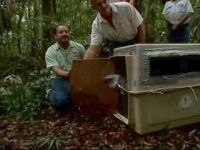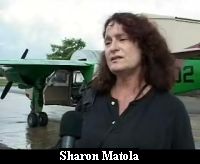
Once upon a time quite long ago, the majestic and powerful Harpy Eagle
was the alpha predator in many parts of Central America. Through habitat –
loss – the Harpy was on the verge of extinction, but through a programme
by the peregrine fund with partnership of the Belize Zoo, the largest Eagle
of the Americas is making a comeback. And they are doing particularly well in
Belize.
While the first one Panama came to the Belize Zoo in 2003, the idea
since has been to re-introduce them in the wild so that someday your children
will be able to know this majestic creature as it exists in its natural habitat.
That effort went one step farther today when an eagle called hope was given
wing. Hope was flown into Belize from Panama last week and is tonight in the
wild of the Rio Bravo Reserve. 7News was at the air wing when she was sent off
and through the kindness of Richard and Carol Foster we have images of her release
at Rio Bravo. Here’s the story.
Jacqueline Godwin
Reporting,
Hope’s journey to the Rio Bravo Reserve started off here
at the Belize Defence Force Air Wing where the bird, one of the top predators
in the world was taken in this carrier and placed carefully in the rear of the
defender. Hope is the fifteenth bird to be released and hopefully will do his
part to restore its healthy population.
Sharon Matola, Executive Director - Belize Zoo
“Remember they are top predators so there were never a huge amount
of these eagles because they are solitary large birds of prey but they were  there, they were documented and bit by bit as top predators go, if their habitats
are altered or degraded, it only takes one shotgun to eliminate a mating pair.
If that keeps happening over time, they are considered to be extirpated from
Central America meaning no more.”
there, they were documented and bit by bit as top predators go, if their habitats
are altered or degraded, it only takes one shotgun to eliminate a mating pair.
If that keeps happening over time, they are considered to be extirpated from
Central America meaning no more.”
And that is why the raptor restoration programme spearheaded by the Peregrine
Fund in collaboration with the Belize Zoo is very critical for the survival
and conservation of these magnificent birds.
Sharon Matola,
“We have a few here now but if we are responsible, if we manage and
protect our forest, they will be here in the future and I am excited about that.
The importance of Hope is that Hope the harpy eagle is melded towards the
whole of climate change because we need that forest out there to decrease the
impacts of climate change. Just by having the forest there is maintaining habitat
and that is one of the best defenses against those negative impacts and guess
what, harpy eagle needs the rainforest too. So there is the natural tie-in,
it is about forming a strong and beneficial alliance with nature.”
The significant effort being made has caught the attention of both the US Ambassador
to Belize and the British High Commissioner who accompanied Hope on his trip
to his new home.
Sharon Matola,
“This guy was captive bred in Panama. In 2005 he hatched, trained
to be an independent hunter, he knows how to hunt, released in the forest there
– what they have found out is that our program is far more successful
as far as the bird surviving. Hope, the harpy eagle as well as the rest of the
eagles is followed by satellites wherever they go, what they eat, what their
secrets are so to speak.”
To mark the occasion the Belize Zoo, Animal Management Supervisor Humberto
Wohlers will be accepting this poster on behalf of the Ministry of Natural Resources
and Forestry. The gift bears a picture of Panama one of the first three harpy
eagle to arrive in Belize six years ago.
Humberto Wohlers, Management Supervisor - Belize Zoo
“Well it is one of the birds that has been around in Belize, there
are not much of those birds here, we are trying to restore the population back
into the forest of Belize.”
Sharon Matola,
“There are two more harpys that need to be trapped in Panama and then
brought to Belize. Right now if some of these birds get together and start their
bonding behaviour, they do mate for life and we are looking at a sustained population
for the next generation. So it is really really great.”
Reporting for 7News, Jacqueline Godwin.
A harpy eagle male weighs 10-16 pounds and the Female 14-18 pounds
with a wingspand of 7 feet.



